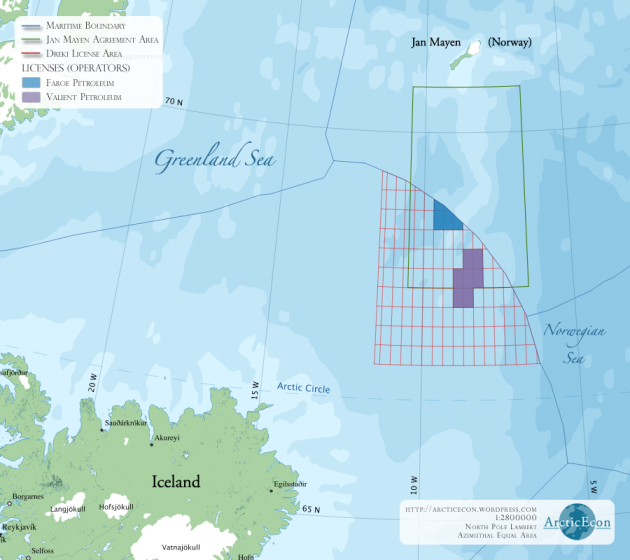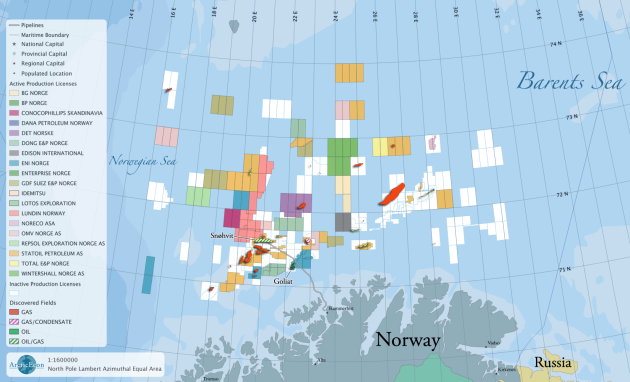Iceland’s New Era of Offshore Exploration
January 14, 2013 1 Comment
Licenses for the exploration and production of hydrocarbons were issued by Orkustofnun (Iceland’s national energy authority) on the 4th of January, 2013. Both licenses fall within the ‘Dreki Area’ section that is subject to an Iceland-Norway agreement from 1981, and thus Norway was given, and has accepted, the right to a 25% share in the project. Norway will be participating through the licensee ‘Petoro Iceland AS’ branch, in Iceland.
- The first license (in purple on the map above) falls within the blocks IS60808/8, 9, 10, 11, and 12 and covers an area of 2,704 km^2. Faroe Petroleum Norge AS is the operator with a 67.5% share. Petoro Iceland AS and Islenskt Kolvetni ehf. have a 25% and 7.5% stake respectively.
- The second license (in blue) includes blocks IS6808/1, IS6809/2, and 3, and IS6909/11, and 12. This covers an area of 1,119 km^2. Valiant Petroleum ehf. is the operator with a 56.25% share. Petoro Iceland AS and Kolvetni ehf. have a 25% and 18.75% share respectively.
Previous concerned posts from 2012;
- May 5, 2012 – Three Applications for Iceland’s Second Licensing Round
- February 24, 2012 – Oil Formations of Iceland’s Dreki Region Confirmed
Economic Development
The developing offshore exploration industry will require new service centers. The Dreki Area faces the northeastern side of Iceland, and the communities of Langanesbyggð and Vopnafjörður have thus been selected as partners for the creation of a Dreki Area service centre. The consortium will fall under Dreki Area ltd.
- Vopnafjörður is the planned initial exploration service centre location.
- Finnafjörður will likely be the future home to a deep water port due to appropriate water depth and wind conditions. The area is also seen as ideal for industrial development.
- Þórshöfn has an airport and heliport. The airport will be enlarged to accomodate for regional development.
- Electricity for the servicing industry will be brought in on 220 kW connections via the National Power Network
A National Oil Fund
The president of Iceland, Ólafur Ragnar Grímsson, announced in December, 2012 his intention to set up a national wealth fund. From IceNews, 20th of December, 2012;
Iceland’s premier has said that Reykjavik is to set up a wealth fund ahead of a potential offshore oil boom to protect the country’s revenues. President Olafur R. Grimsson’s comments came during an interview in London in which he told the media, “Since we look at this resource as a national wealth, there will be a national wealth fund that would be established, but this is more of a general policy at this time,” Bloomberg reports.
This is similar to what many resource-rich countries have done. In the local area, Norway currently runs a rather impressive fund from oil-related activities, and Greenland was hoping to do the same as it continues to explore offshore.
Opinion
This news is not going to come lightly to many. The protests in response to the construction of the Kárahnjúkar Hydropower Plant were widespread, albeit for the implementation of one of the least CO2 intensive energy producing technologies available. With that, I would assume that the construction of the offshore oil servicing industry will beckon much more.
The advantage for one of the most ably independent and clean countries on earth will be their ‘opportunity’ to eventually become independent of foreign oil sources. Over 99% of the electricity generated in Iceland in 2011 was Hydroelectric or Geothermal in origin. (Note that electricity generation does not originate from 100% renewable sources as some sources claim, but Iceland is quite close. The amount of fuel used, in fact according to Orkustofnun, in electricity generation has been declining steadily over the last 30 years and amounted to only 2 GWh in 2011.) According to the IEA, the country in 2009 imported 157,000 tonnes of motor gasoline (used for transportation), 114,000 tonnes of jet kerosene, 357,000 tonnes of gas/diesel (for industry, transportation, and fishing), and 96,000 tonnes of fuel oil (for industry, transportation, and fishing). The thing to note is that all of this must be imported, meaning regular risks of spills into coastal ecosystems upon each import. What is more, is that the quantities imported each year in both petroleum products, and natural gas are increasing year over year.
From the above, it is clear that risks both exist and are quite frequently ignored. The issue shares components with that of the Icelandic aluminium smelting industry. Smelting in Iceland will result in a lesser global CO2 footprint due to the hydro component than would have otherwise been realized had said smelting occurred in a coal-intensive region. Similarly, oil that is produced and refined (in the future) in Iceland could face greater negative externalities that could have otherwise been realized had said production and refining occurred in a region with an easier-to-access reserve, for example. It may thus come down to a desire for independence or a desire for economic growth and development, rather than for global efficiency in determining the next stages. Will Iceland want energy independence not only in terms of electricity, but in gasoline, kerosine, diesel etc.., as well? They may alternatively take the less strenuous route and simply sell their crude, and continue to import products as needed as they have been.
Sources
- Orkustofnun. Generation of Electricity in Iceland. [ONLINE] Available at: http://www.nea.is/the-national-energy-authority/energy-statistics/generation-of-electricity/. [Last Accessed 13 Jan 2013]
- Orkustofnun. Iceland issues the first licenses for exploration and production of hydrocarbons in the Dreki Area. [ONLINE] Available at: http://www.nea.is/the-national-energy-authority/news/nr/1311. [Last Accessed 12 Jan 2013]
- IceNews. Iceland president: government to set up wealth fund for oil revenue. [ONLINE] Available at: http://www.icenews.is/2012/12/20/iceland-president-government-to-set-up-wealth-fund-for-oil-revenue/. [Last Accessed 13 Jan 2013]
- United Nations. Conciliation Commission on the Continental Shelf area between Iceland and Jan Mayen: Report and recommendations to the governments of Iceland and Norway, decision of June 1981. [ONLINE] Available at: http://untreaty.un.org/cod/riaa/cases/vol_XXVII/1-34.pdf. [Last Accessed 13 Jan 2013]
- Dreki Area. Booklet. [ONLINE] Available at: http://drekiarea.is/servicing_the_arctic/. [Last Accessed 13 Jan 2013]
- Statistics Iceland. Imports in goods. [ONLINE[ Available at: http://www.statice.is/Statistics/External-trade/Imports [Last Accessed 13 Jan 2013]







 On the 13th of July, 2012 a Russian draft law, setting out to label all politically affiliated NGOs with activities funded from abroad as ‘foreign agents’, passed through the State Duma with barely any opposition. Russian activists are now in strong opposition along with foreign governments. Said NGOs would have to register as foreign agents and include this label on all publications and web-portals. Apart from being labelled ‘foreign agents’, NGOs would be subject to frequent audits and spot checks.
On the 13th of July, 2012 a Russian draft law, setting out to label all politically affiliated NGOs with activities funded from abroad as ‘foreign agents’, passed through the State Duma with barely any opposition. Russian activists are now in strong opposition along with foreign governments. Said NGOs would have to register as foreign agents and include this label on all publications and web-portals. Apart from being labelled ‘foreign agents’, NGOs would be subject to frequent audits and spot checks.

